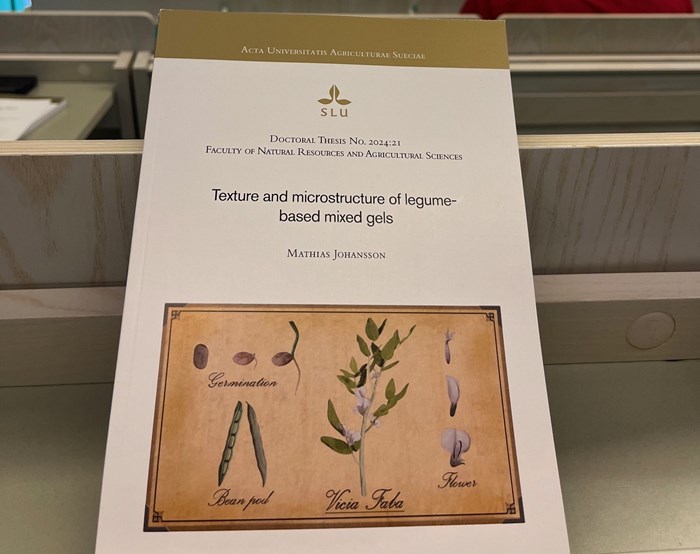What are the secrets behind legume-based mixed gel texture?

Unsustainable food production and consumption are common threats contributing to climate change and global environmental degradation. Transitioning towards a more plant-based diet can mitigate these threats. To achieve this, healthy and tasty plant-based foods need to be readily available. Taking action now can secure our future!
Mathias Johansson successfully defended his PhD thesis "Texture and microstructure of legume-based mixed gels" at Swedish University of Agricultural Sciences on April 5th, 2024.
Opponent: Professor Christophe Chassenieux, PCI Laboratoire IMMM Avenue Olivier Messiaen, 72085 – Le Mans Cedex 09, France
Main supervisor: Professor Maud Langton
Associate supervisors: Anna Ström, Corine Sandström.
LiFT mentor: Annelie Moldin from Lantmännen.
Mathias’ work provides valuable insights into the broader context of developing sustainable and attractive plant-based foods from local ingredients. Knowledge about gel formation by proteins from alternative plant-based sources opens new avenues for the creation of innovative, tasty and environmentally-friendly foods that can promote a shift towards a more sustainable plant-based future. “To make people choose plant-based food, food should be available, tasty and healthy”, underlines Mathias.
Legumes, like beans and lentils, are common sources of plant-based protein. They are also rich in dietary fibre and minerals, providing nutrition and health benefits. During protein extraction from starch-rich pulses, most starch and fibre turn into waste or side-streams. Incorporation of these side streams back into the food supply chain is essential and can reduce waste and make production more sustainable.
Gel formation is important for making foods like yoghurt, sausages, and desserts. To create tasty plant-based foods, it is vital to understand how proteins form gels. While soy and milk proteins are well-studied, we don't know as much about how other proteins form gels. This thesis fills that gap by exploring how the texture and structure of mixed legume gels are connected. Mathias examined the possibility of creating textured foods using protein from non-soy legumes, with particular emphasis on gel formation by faba bean protein since this crop can be grown in northern Europe. Mathias studied the gelation process with small amplitude oscillatory shear measurements and the final gels with light and electron microscopy. He also used rheology and textural analysis to study the gel formation and textural properties.
In an attempt to create gels with desired properties and reduce waste from process side streams, Mathias studied the mixed gels containing protein together with starch and fibre fractions obtained during protein extraction. He found that the addition of starch and fibre influenced fracture stress differently, depending on gel microstructure, and caused an increase in gels with large protein particles and a decrease in fine-stranded, homogeneous protein gels.
Congratulations to Mathias and best of luck in his future career!
Link to the thesis: https://pub.epsilon.slu.se/33084/1/johansson-m-20240301.pdf
Link to the summarizing video about Mathias research: https://www.youtube.com/watch?v=Vx25eWQOE3M&t=105s


